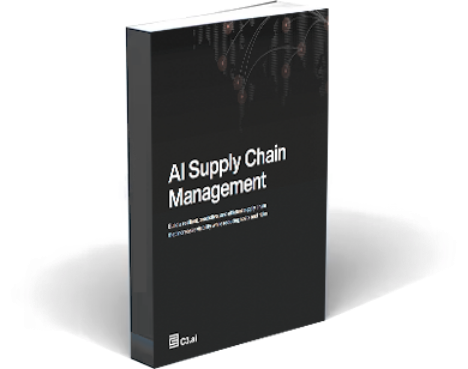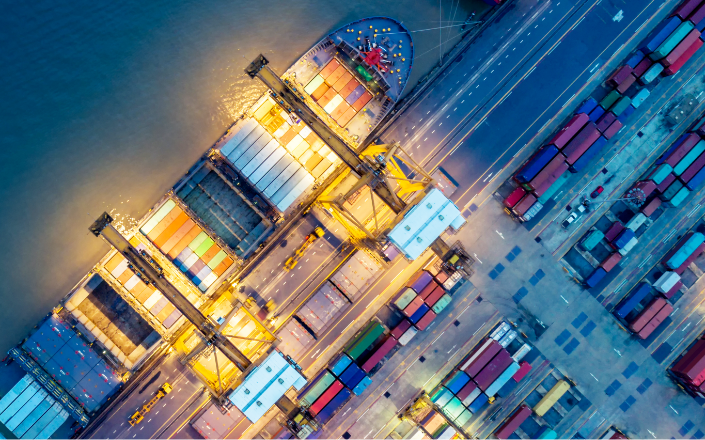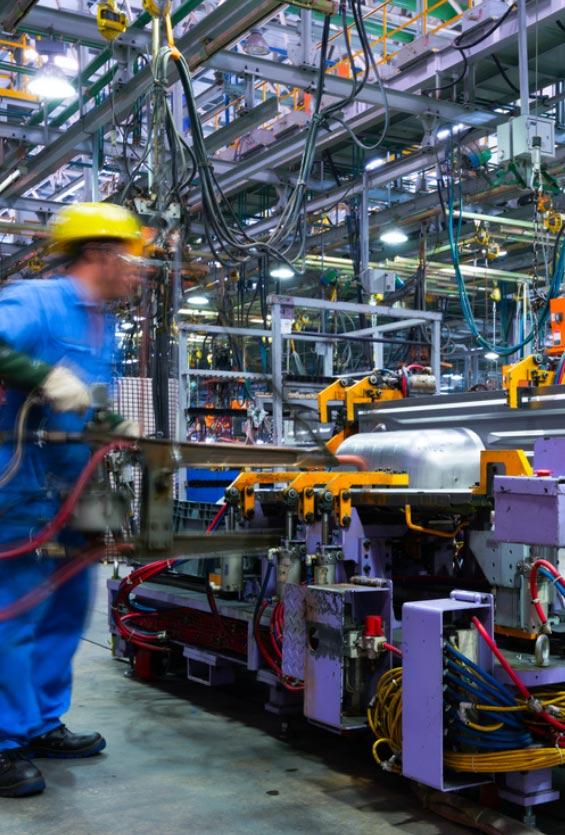Supply chain executives with complex, global operations are under tremendous pressure to meet production demands, reduce costs, and improve customer satisfaction amidst increasing global trade tensions and supplier performance challenges.
To keep up, supply chains need to become more agile and resilient. A resilient supply chain provides visibility, predictability, and flexibility with the addition of supply chain AI solutions and applications that make recommendations based on dynamically changing, real-time data. We call this an AI-driven supply chain. Building these capabilities requires technical and domain expertise that only an organization with years of experience in developing enterprise AI and machine learning applications possesses.
Challenges of Managing a Supply Chain Today
The pandemic, war in Ukraine, labor and chip shortages, and other disruptions have served as a reminder that global supply chains are fragile. In isolation, each of these disruptions appears to be a once-in-a-century event. However, the frequency and magnitude of these disruptive events are growing.
According to the McKinsey report on Risk, Resilience, and Rebalancing in Global Value Chains, manufacturers with complex global operations should expect major supply chain disruptions – events lasting one month or more – at least once every 3.7 years. Causes, including financial crises, geopolitical tension, terrorism, extreme weather, and, yes, pandemics can result in severe financial consequences for businesses. Further, gaps in supply chain visibility have multiplied with greater globalization, leading to challenges in monitoring supply networks in real time, obtaining delivery data, and generating actionable insights.
Today, organizations grapple with using the latest technological advancements for a more predictive supply chain to respond to a volatile and complex world.
In a recent survey by Capgemini Research Institute, 80% of supply chain executives from 1000 organizations across diverse industries (e.g., CPG, retail, discrete manufacturing, and life sciences) shared similar concerns about the stability and resilience of their current supply chains:

Supply chains have historically faced complexity with the volume and variety of products produced, access to technically savvy suppliers, and trade-related issues. In a digitally native world, these challenges also include the proliferation of data across unintegrated systems, lack of global real-time visibility, demand uncertainties, supplier network risks, and the lack of comprehensive part-level visibility. Harnessing this data and making it available for timely analysis is perhaps one of the biggest challenges of the digital supply chain.
The Potential for Artificial Intelligence in Supply Chains
The business environment today is marked by unparalleled speed and volatility, demanding companies to adopt fresh approaches to remain competitive. Agility and responsiveness have become critical attributes for supply chains, enabling organizations to adapt quickly and effectively to shifting market demands and unexpected disruptions.
As technological advancements continue to shape the business landscape, companies must embrace artificial intelligence in supply chain management. As organizations begin to further analyze data to evaluate and build a more intelligent supply chain, they should consider the following attributes for AI-enabled, intelligent, and resilient operations:
- The next generation of supply chains must be able to continuously monitor for variances and delays at every stage, predict their impact, and recommend proactive responses.
- Any solution should be designed both for efficiency and to deal with uncertainty.
- An AI supply chain should manage risks with holistic and AI-powered scenario modeling.
1. Shift to Proactive Response
Supply chains need to transition from a reactive approach to a proactive one. Adopting a proactive approach involves anticipating and mitigating potential disruptions and bottlenecks before they occur. By leveraging advanced AI for supply chain optimization, predictive modeling, and real-time monitoring, companies can gain valuable insights into their supply chain operations and identify potential risks or opportunities well in advance.
This shift allows for the implementation of strategic measures to optimize business processes, enhance efficiency, and improve overall supply chain resilience. Proactive supply chains not only ensure uninterrupted operations but also empower organizations to anticipate market fluctuations, customer demands, and emerging market trends, enabling them to stay ahead of the competition and deliver superior customer satisfaction.
2. Plan for Uncertainty
Building comprehensive plans for supply chains is crucial to mitigate risk and uncertainty in today’s dynamic business environment. By developing robust plans, companies can proactively identify and assess potential risks, and implement measures to minimize their impact. These plans allow for the development of contingency strategies, alternative sourcing options, and backup inventory management, ensuring business continuity even in the face of unforeseen events.
Furthermore, planning helps to establish clear communication channels and coordination among stakeholders, enabling swift decision-making and agile responses to mitigate disruptions. Additionally,
having contingency plans in place enhances supply chain resilience, instilling confidence in customers and partners and safeguarding the reputation and profitability of the organization.
3. Design for Resilience
A resilient supply chain is characterized by its ability to anticipate, adapt, and recover from disruptions while minimizing the impact on operations. Several key factors must be considered. First and foremost, diversification is vital, both in terms of suppliers and geographic locations. By having multiple sources of supply and manufacturing facilities spread across different regions, the risk of single points of failure is reduced. Additionally, incorporating real-time monitoring and analytics tools allows for early detection of potential disruptions, enabling timely intervention and response.
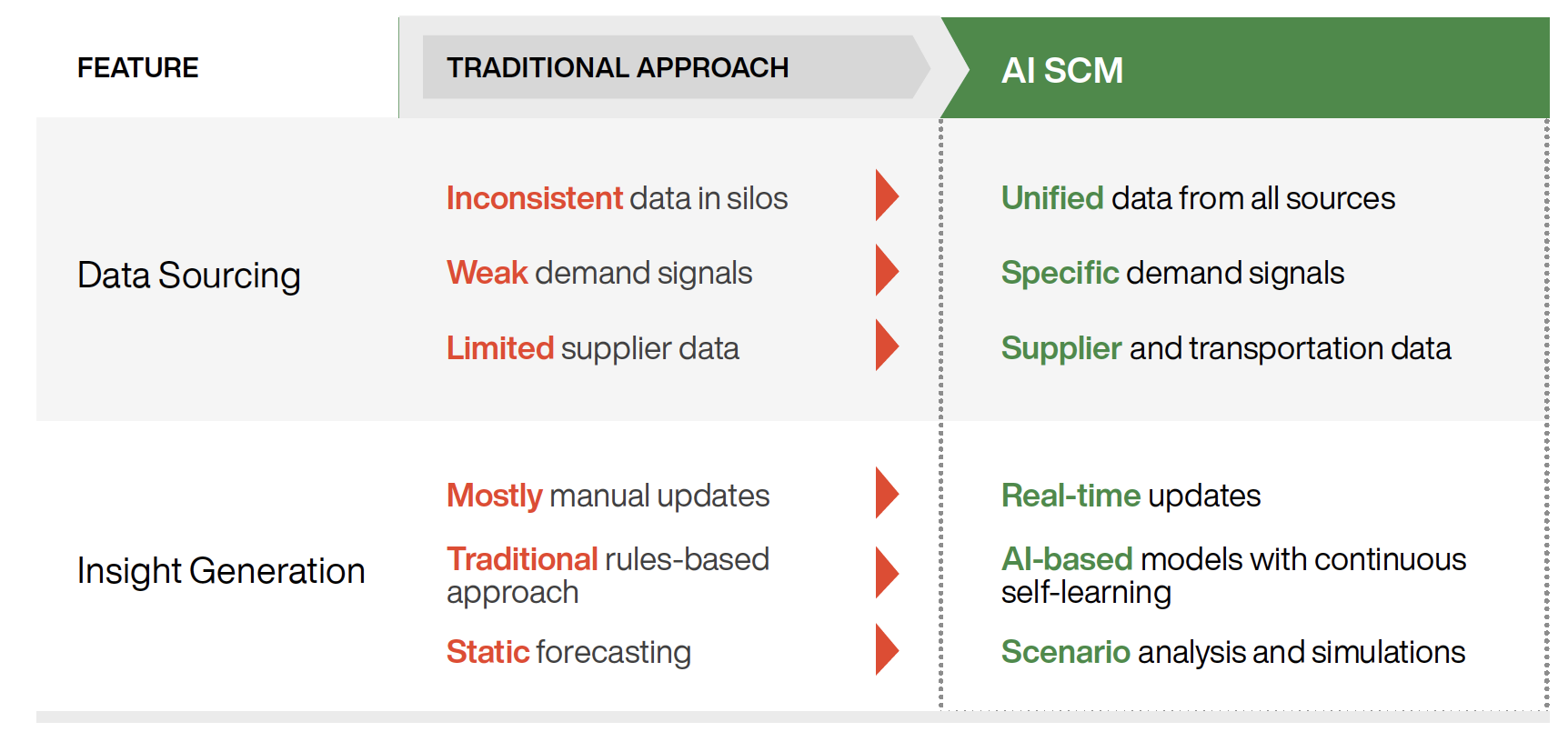
Collaborative partnerships with suppliers and customers foster transparency and enable proactive risk management. Implementing agile practices, such as flexible production capabilities and just-in-time inventory management, enhances responsiveness and minimizes excess inventory. Finally, investing in advanced technologies like AI, machine learning, and automation enables efficient decision-making and process optimization. By integrating these strategies and technologies, a resilient supply chain can effectively withstand disruptions, maintain business continuity, and ensure customer satisfaction.
Typical Use Cases for Applying AI in Supply Chain
There are many artificial intelligence supply chain uses cases. Any supply chain process that can benefit from the power of prediction, is a good candidate for the application of AI.
- Demand forecasting: Many enterprises employ limited demand forecasting and demand sensing capabilities that are inflexible, based on insufficient data, and inaccurate. AI can improve visibility across demand signals, flexible segment-specific demand models, and a constantly updated forecast as new data becomes available. This improves operational efficiency, order fill rates, service levels, and planner productivity.
- Production planning: Manufacturing scheduling is complex and made harder by evolving customer demand, supplier uncertainties, broader market movements, and operational constraints. Traditional rule-based planning systems and deterministic optimizers fail to respond to the ever-changing market conditions and do not consider all operational constraints. AI can create optimized production schedules based on selected objective functions and operational constraints, adjusting and fine-tuning production to meet the latest demand picture and supply conditions. AI-driven production planning can improve customer on-time delivery, prioritize production across products, minimize production and distribution costs, and minimize the cost of last-minute changes.
- Inventory Planning: Most companies use material requirements planning (MRP) for inventory planning, which usually lacks the ability to apply advanced optimizations, respond to dynamic changes in data during the execution of plans, and model supply chain uncertainties. As a result, companies often adopt conservative inventory policies to maintain a buffer against uncertainties that MRP systems cannot account for, leading to a higher cost of inventory and higher markdowns. AI can model real-world uncertainties in demand and supply, continuously optimize and reset reorder parameters, and optimize assortment mix and inventory levels. AI-based inventory planning reduces unwanted inventory levels, improves visibility of critical uncertainties, and improves order fulfillment rates.
- Sourcing: Most enterprises lack holistic visibility into sourcing operations, leaving unwarranted price variations undetected and exposing their operations to undue supplier risk. Artificial Intelligence in supply chain sourcing can help provide a unified view of all activities to identify anomalous price changes, supplier risk profile changes, and emerging cost-saving opportunities. AI-based sourcing helps comprehensive monitoring of sourcing activity, mitigating supplier risks, and improving operational efficiency.
- Supply Network Design: Many supply networks are a culmination of one-off decisions or designed based on rules-based simulations, that lead to rigidities in the supply chain and undue risk. AI-powered scenario modeling helps design flexible and disruption-resistant supply chain strategies with holistic, interconnected scenarios and a focus on system-wide optimization. This leads to long-term agility, cost advantage, risk mitigation, and customer responsiveness.
- Logistics Management: Transportation and logistics are often the cause of supply chain disruptions and can have a ripple effect. AI is useful in identifying the impact of emerging logistical issues and taking proactive and timely actions based on likely scenarios. Transportation routes can be AI-optimized for desired objectives, such as cost, delivery times, or risk, and can recommend alternative routes as new conditions emerge. AI-driven logistics management can help find the right balance between transportation costs, customer responsiveness, and delay risks.
- Warehouse Management: AI can optimize warehouse operations by identifying packages at risk of delivery delay, optimizing routes, and automation with robotics. This can have a material impact on warehouse throughput, operating costs, and customer responsiveness.
- Supply Risk Management: AI can monitor supplier health, learn from supplier delivery history, and identify orders at the highest risk of delays, thereby improving customer delivery and reducing cost.
- Sustainable Operations: Supply chain operations – from sourcing and contract manufacturing to warehousing and transportation – can have a significant carbon footprint. Measuring, monitoring, and assessing the environmental impact of supply chain operations and accordingly identifying initiatives to improve their sustainability, is a role that AI is perfectly suited for.
View AI Supply Chain Presentations
Optimizing Global Supply Chains
Jim Apostolides, Senior Vice President Enterprise Operational Excellence
Transforming Supply Chains with Enterprise AI
Mark Ratcliffe, VP Global Supply Chain Planning, Cargill
Role of Generative AI in Supply Chain Management
Generative AI has the potential to improve monitoring, analysis, and management of supply chains, revolutionizing global operations and delivering significant benefits in terms of cost savings, efficiency, and sustainability.
Generative AI can help enterprises:
- Identify potential suppliers by analyzing large amounts of data to identify suppliers that meet specific procurement criteria such as product availability, quality, price, and service levels.
- Improve sourcing productivity by creating RFPs, evaluating bids, creating shortlist recommendations, and drafting contracts. This will free up time for procurement professionals to focus on more strategic tasks.
- Optimize logistics operations by analyzing data such as traffic patterns, weather, and fuel prices to recommend the most efficient routes and modes of transportation.
- Assess the environmental impact of supply chain operations, allowing for assessment and reduction of carbon footprint and achievement of sustainability goals.
Benefits of AI-Driven Supply Chains
AI can have a transformative impact on supply chain operations, making them not just more efficient and agile, but also more resilient and future-proof. There are many benefits of AI in supply chain:
Challenges in Implementing AI in Supply Chains
Large industrial manufacturers rely on IT and OT infrastructure, systems, and applications to manage their operations and supply chains. Data gathered from the manufacturing environment can identify critical parameters and generate key insights to help drive value for the organization, such as better visibility into the entire supply chain, inventory optimization leading to cost reduction, improved asset availability via predictive analytics, and determining supplier risk using internal and external big data analytics.
However, much of these data are often locked up in isolated legacy systems and not readily available for value creation by planners and operators. According to IDC, the data generated from industrial operations triples every five years, and while data consumption (populating downstream analytics, business intelligence, and AI applications) continues to grow over time, a significant portion (over 70%) remains unexamined, limiting the potential value to be gained from these data.
In addition to data harnessing, there are numerous other challenges in implementing AI at enterprise scale in supply chain operations:
- Delayed implementations: Many AI implementations take years to complete if they ever get past the proof-of-concept stage.
- Lackluster returns: While most AI implementations do provide some business benefit, most supply chain projects are hobbled with poor measurement of benefits and low returns because of sub-scale implementation.
- Change management: Traditional ways of managing supply chains are hard to change, despite the transformative potential of AI.
- Confusion: Every vendor, from traditional ERP providers, supply chain planning solutions, cloud-based supply chain solutions, and point solutions, claim to provide a comprehensive AI-based supply chain management suite. Moreover, cloud service providers such as AWS and Microsoft provide a series of services that they market for building AI-based supply chain solutions.
Key Steps in Implementing AI in Supply Chain
1. Create a Supply Chain Digital Twin
A supply chain digital twin is a virtual replica and a parallel version of an organization’s physical supply chain and its supplier network. Like the physical world, the digital network is interconnected and vast – representing millions of SKUs, thousands of suppliers and customers, hundreds of warehouses and logistics centers, and innumerable routes connecting each node. This supply chain digital twin provides end-to-end, granular traceability of materials and goods from source to destination. It contextualizes movements and activity across logistics networks with external factors, providing all relevant information to make sense of what has happened and is going to happen at any point across time and space of the supply chain.
By deploying a supply chain digital twin, an organization gains unprecedented visibility, and therefore predictability and control, into its distributed and interconnected production networks. The sources of supply chain data in large manufacturing organizations are often legacy enterprise systems such as ERP, MRP, Analytics and CRM systems. Other relevant data include demand forecasts, planning calendars, and sensor data, as well as external sources such as weather, GIS, market data, social media, pricing, and any other relevant data. To start, data must be ingested, deduped, cleansed, transformed, normalized, and finally prepared for analytics.
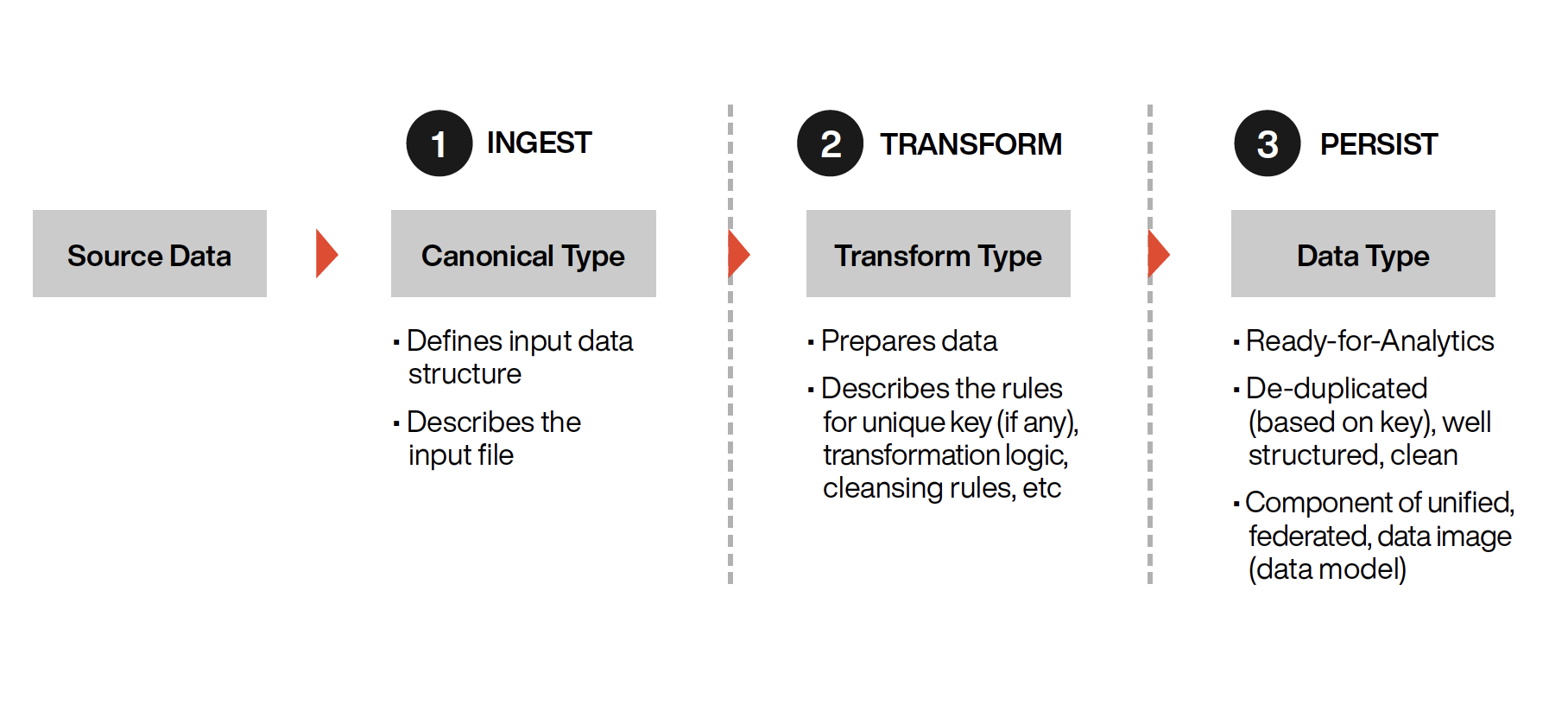
2. Ingest Data and Make Predictions and Recommendations in Near Real-Time
In a traditional operation, supply chain managers and planners are typically forced to work with inconsistent and outdated data. This results in manual processes to adjust inventory levels, evaluate risks, and generate sub-optimal plans.
AI-driven smart supply chain solutions offer a quantifiable shift from traditional manual operations to the creation of data-driven, automated, and predictive real-time recommendations. AI-enabled supply
chains can receive demand signals as they arrive, updating demand forecasts and supply risks dynamically. This provides companies with greater agility, while ensuring that the supply chain is recognizing and resolving risks as they occur.
AI-driven supply chain management applications model uncertainties to allow supply chain professionals to optimize re-order parameters by part and by location and to gain visibility throughout their supply chain operations. For example, supply chain professionals can now identify vulnerable sources of raw materials or weaknesses in hubs and aggregation points. Planners and operations managers gain insight into potential delays and recommendations that result in improved (On Time In Full) OTIF performance leading to increased customer satisfaction. C3 AI Inventory Optimization is an example of an AI-driven application that combines supply chain digital twin functionality with AI and machine learning models that improve visibility, reduce inventory holding costs and increase productivity of inventory analysts through automated recommendations. This application is designed to model and learn from uncertainties and provide recommendations that are used as inputs into existing MRP modules.
3. Apply AI to Your Highest-Value Use Cases
Not all AI and supply chain use cases are equally valuable for your enterprise. Selecting the right opportunity with the right parts of your supply chain can have a significant impact on the trajectory of your program. Assess AI opportunities in your supply chain based on the economic value they can generate and the level of complexity in implementing the AI application. When deciding on the best AI technology to employ, it is crucial to prioritize the scalability and adaptability of the chosen solution. This ensures that future business growth and changes in the environment are effectively addressed.

How to get started?
Deploying the first AI application is a great way to get started in addressing the priority opportunities in your business. It is important to pick a part of your business to do the initial production deployment in that has the data to support the use case, a leadership team committed to making the change, and resources to implement the initial production deployment and drive adoption.
Look for software providers that have the right mix of supply chain expertise, pre-built AI applications, and a platform that can address multiple use cases and sustain a long-term transformation of your supply chain.
Learn how to build foundational capabilities, accelerate deployment, and achieve supply chain resiliency with the C3 Supply Chain Suite of Applications.
C3 AI Supply Chain Suite Applications
To learn more or get started, please schedule a briefing.

